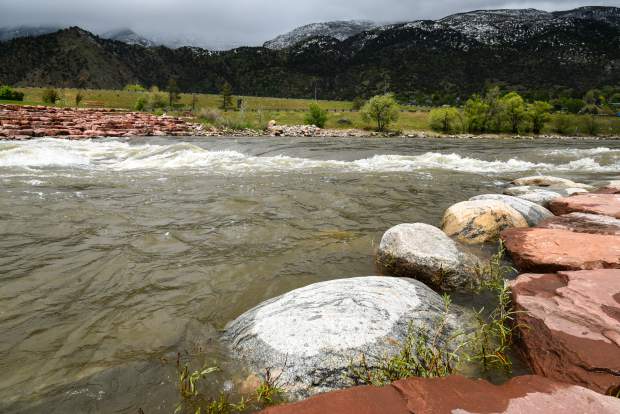

Chelsea Self / Post Independent
Despite recent precipitation adding to an above average snowpack, local meteorologists and conservationists do not anticipate any flooding for the next few days.
“The biggest issue will be if we get a big warm up — if we suddenly come out of this cool pattern and we get really hot and dry,” National Weather Service Meteorologist Ben Moyer said. “Then everything melts really quickly and flows into the river channels and there is just too much to handle.”
At this point, Moyer did not foresee any risk of flooding in the coming weeks as cooler than normal temperatures remain in the forecast.
“That is going to help keep things calm,” Moyer explained.
“The biggest issue will be if we get a big warm up. If we suddenly come out of this cool pattern and we get really hot and dry. Then everything melts really quickly and flows into the river channels and there is just too much to handle.”-Ben Moyer, National Weather Service Meteorologist
As of late Tuesday afternoon, according to the United States Geological Survey (USGS) agency, the Roaring Fork River in Glenwood Springs had a volumetric flow rate of 1,860 cubic feet per second.
The Colorado River near the confluence had a volumetric flow rate of 5,910 cubic feet per second. The flooding concern comes when those flow volumes start to approach 15,000 cfs or more.
As of now, though, both rivers’ flow rates were measuring below average for this date in Glenwood Springs.
“For the next few weeks we are expecting below normal temperatures and continued chances of higher than normal precipitation,” Moyer said. “Since the temperatures aren’t getting too warm, and in fact they are staying pretty close to freezing up where the snow is right now, then not much will be coming off and flowing into the river channels.”
District Conservationist Stephen Jaouen with the Natural Resources Conservation Service (NRCS) said that, even with 2019’s above average snowpack, the Upper Colorado River Basin had yet to reach any of its “maximums.”
“We are not at anything beyond what we’ve seen in the last 30 years, but we are still above normal,” Jaouen said of the basin. “The Roaring Fork Basin itself is a little bit higher than [the Upper Colorado River Basin], but it’s still not touching maximums in the last 30 years.”
Additionally, Jaouen explained how many reservoirs were still recovering and refilling after last year’s dismal snowpack and multiple years of drought conditions.
According to Jaouen, Ruedi Reservoir in March was the lowest it had been in a decade.
Although cooler temperatures were helping facilitate slower runoffs, Jaouen and Moyer explained how conditions always had the ability to change quick, particularly in the high country.
“Bear in mind … we are moving into the peak of the snowmelt season, so yes rivers will be running higher than normal,” Moyer said. “And, whether or not there is actually going to be flooding will be dependent on exactly how warm we get.”
Basalt, facing a different scenario in the wake of last year’s Lake Christine Fire, will continue to roll out further public information concerning mud and debris flow potential from the historic fire’s scar area.
Taking no chances, the city of Glenwood Springs has stocked up on sandbags should any flooding situations arise farther down valley.
“Not knowing what the local retail market might have available in the way of sandbags, I requested that the city stock up on some sandbags to have available,” Glenwood Springs Fire Chief Gary Tillotson said.
